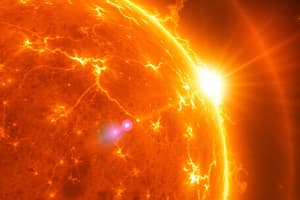Podcast
Questions and Answers
What is the radiative zone?
What is the radiative zone?
- The layer where heat is generated through nuclear fusion.
- The outer layer of the sun where photosynthesis occurs.
- The layer of the sun through which energy is transferred away from the core by radiation. (correct)
- The layer responsible for solar flares.
What is the convective zone?
What is the convective zone?
- The sun's surface.
- The region where solar wind originates.
- The layer where energy travels by conduction.
- The layer of the sun through which energy travels by convection. (correct)
The sun rotates on its axis like other solid bodies.
The sun rotates on its axis like other solid bodies.
False (B)
How does the sun rotate compared to the Earth?
How does the sun rotate compared to the Earth?
Near the equator, the sun rotates once in about ______ days.
Near the equator, the sun rotates once in about ______ days.
At the poles, the sun rotates once in about ______ days.
At the poles, the sun rotates once in about ______ days.
What is differential rotation?
What is differential rotation?
The sun's core and radiative zone rotate together at the same speed as Earth's rotation.
The sun's core and radiative zone rotate together at the same speed as Earth's rotation.
Flashcards are hidden until you start studying
Study Notes
Radiative Zone
- Energy is transferred from the sun's core to the outer layers via radiation in the radiative zone.
- This layer is crucial for energy movement before reaching the convective zone.
Convective Zone
- The convective zone allows energy to travel through convection from the radiative zone to the photosphere.
- This layer is characterized by convective currents that rise and fall, carrying energy.
Sun's Rotation
- The sun rotates on its axis, similar to other celestial bodies.
- Unlike solid objects, the sun, being a massive gas ball, exhibits non-uniform rotation.
Differential Rotation
- Different parts of the sun rotate at varying speeds; this phenomenon is known as differential rotation.
- At the equator, the rotation period is about 25 days, while at the poles it takes approximately 35 days.
Internal vs. Surface Rotation
- The sun's interior (core and radiative zone) rotates at a consistent speed, akin to solid bodies like Earth.
- There is a distinct difference between the rotation rates of the sun's interior and exterior surfaces.
Studying That Suits You
Use AI to generate personalized quizzes and flashcards to suit your learning preferences.




